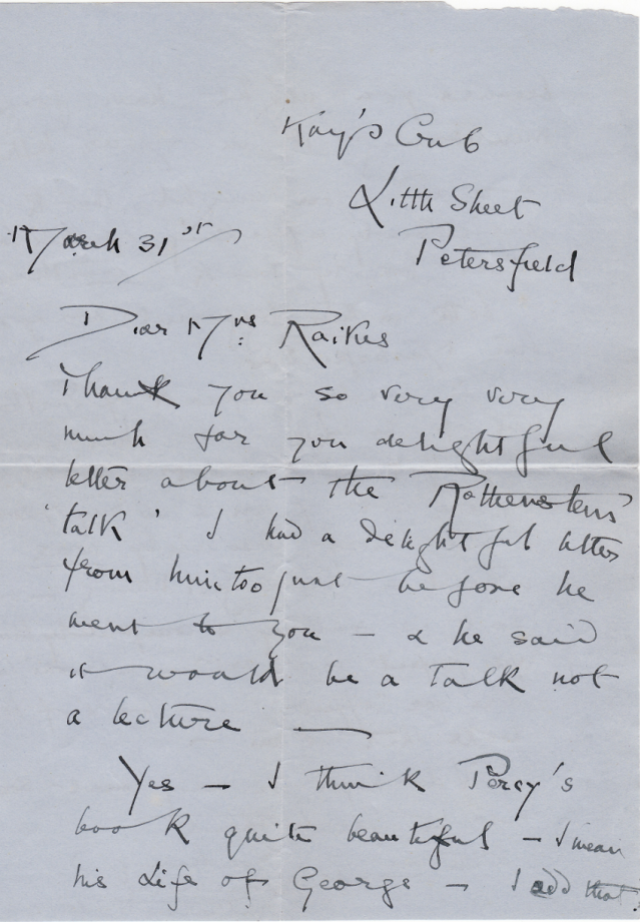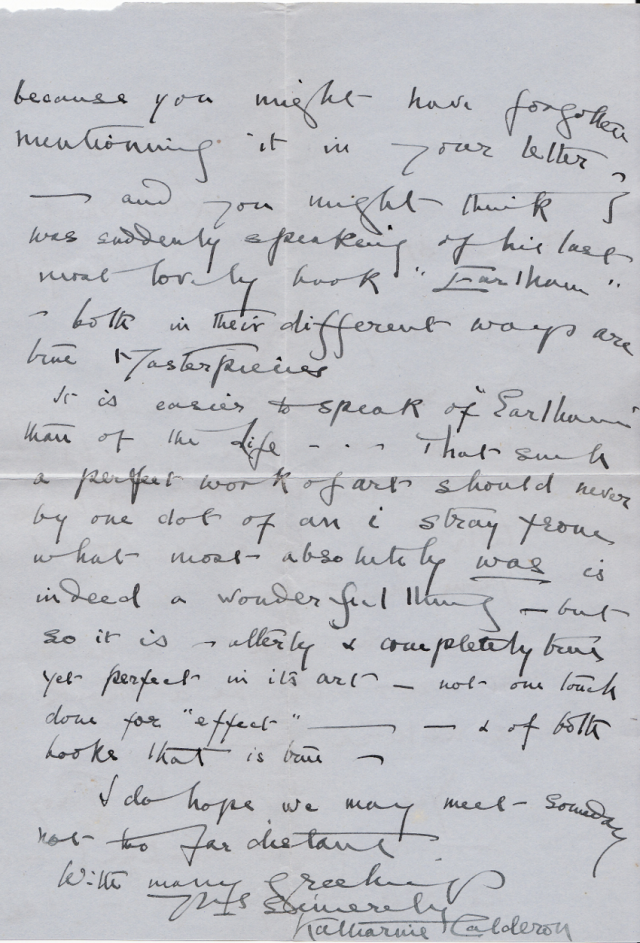Please read Katy George’s and my Comments for the background to this letter, which Katy discovered recently amongst some papers of Mrs Raikes in a charity shop in Deal, Kent. New letters of Kittie Calderon’s are as rare as new ones of George’s! As I shall explain below, this find is invaluable to me as their biographer.
The letter is a very clear example of Kittie’s flying Quangle-Wangle handwriting, so I don’t think it is necessary for me to transcribe it:
In those days, correspondents often just put the day of the week or the day of the month at the top of their letters, so it is brilliant that Kittie’s envelope has also survived, and this is clearly date-stamped 1923. It is addressed to Mrs Raikes at ‘Vinnicks’, Highclere, otherwise known as Downton Abbey, near Newbury… However, this was crossed out and the letter redirected to St Hilda’s Hall, Oxford.
The first matter of great interest is the mention of a ‘talk’ by Rothenstein and the fact that ‘he’ had written to Kittie telling her about it. This is George’s great friend, the painter William Rothenstein, about whom I wrote in my post of 3 January. It so happens that we have an undated letter from Rothenstein to Kittie in which he apologises for having ‘neither talent nor time’ for writing a memoir of George Calderon, but is planning a ‘talk’. Until Katy found this letter to Mrs Raikes, we had no idea that Rothenstein had actually given a ‘talk’. But it seems likely that his undated letter is the very one referred to in Kittie’s letter above, and that he gave the ‘talk’ where Mrs Raikes wrote her own letter from, i.e. at Highclere. Personally, I would have expected Rothenstein to have given the ‘talk’ in Oxford, where he had many literary contacts and where George was still a well-remembered figure who had been an undergraduate at Trinity College and raised a body of student volunteers during the Coal Strike of 1912. Perhaps Mrs Raikes had put her ‘permanent’ address on her own letter to Kittie but actually heard the ‘talk’ in Oxford and was still there, at St Hilda’s, when Kittie replied. No reason springs to my mind, at least, for why Rothenstein would give the talk at Highclere.
The reason Kittie put ‘talk’ in inverted commas, and I have perpetuated this, is that to people of Kittie’s and Rothenstein’s generation and social standing ‘talk’ was a new, rather infra dig word. Edwardians gave ‘lectures’. In his letter which we may now date as 1923, Rothenstein himself apologised to Kittie:
My very dear lady, […] my lectures are nothing more than desultory improvisations. But you will know this talk, however inadequate, will be de coeur. My love for and devotion to George has grown with the years. Just as my friendship was strongest during the last year, it would have remained one of the strong towers in my life. If it is a memory, it is a living and powerful thing. As I grew older, and, I hope, a little wiser and steadier, I learnt to appreciate George’s character more and more. So long as I live you may be sure of my devotion to him and to yourself. There are no two people I love more. So you may imagine it is no common task I am undertaking, but a secret act of homage to two very dear spirits.
This rather suggests ‘Will’ spoke from very few notes and that is why there is no known text/record of his ‘talk’. But at least we now know he gave it.
The inference is that he also referred to Percy’s George Calderon: A Sketch from Memory (1921). Rothenstein’s own copy is in McGill University Library, Canada, and in 2010 Professor Alan Andrews, an expert on George’s fellow dramatist St John Hankin, emailed me to say that he noticed Rothenstein had written on the front end paper: ‘[Page] 90 account of dear George’s relation with me.’
The other subject of great interest to me in this letter is Kittie’s own feelings about Percy’s Sketch from Memory. She thinks it ‘beautiful’ and actually calls it a ‘Life’. The latter is one in my eye, as I have been saying for years that my book is the ‘first biography’ of George Calderon! On the other hand, Kittie had a great hand in this book, supplying a long memoir of George written specially for Percy, and all the biographical material that she thought fit. As a relative of Percy’s once put it to me, ‘he wrote the book for Kittie’. The latter is graphically borne out by the fact that it has a substantial, very moving section devoted to Kittie’s first husband, George’s friend and Percy’s uncle, Archie Ripley. It was very much George’s ‘authorized’ biography, then.
I will say no more about this subject here, except that (1) I have access to all the biographical material Kittie made available to Percy, but also to far more that she did not, (2) there were large areas of George’s life that Percy was not able to summon up a critical interest in, and (3) Calderon and Lubbock had fundamentally different personalities.
Nevertheless, Kittie was obviously pleased with the result, describing both the Sketch from Memory and Earlham as ‘masterpieces’. Although Percy’s prose is perhaps too Jamesian and orotund for our taste today, I would not disagree with that judgement. Earlham is the better-known book, a post-1918 recherche du temps perdu that has had great influence down the generations and never, it seems, been out of print. But the ‘Life’ is such a personal matter for Kittie that she implies with her three dots that she can’t talk about it… It is extremely interesting to see what she has to say about Earlham, for which she drew the frontispiece in the first edition, as she knew the place well from when she was married to Ripley. ‘Utterly and completely true yet perfect in its art — and of both books that is true’ is a very valuable statement to have from her.
I cannot add much about Mrs Raikes to what I have said in my response to Katy George’s Comment. However, thanks to the indefatigable labours of Mr Johnnie Pym, Evey and Violet Pym’s grandson, I can tell followers that the desire Kittie expresses in the last paragraph of this letter soon came true: Mrs Raikes’s late husband was a friend of Major C.E. Pym (‘Evey’), who invited her and her two sons to stay at Foxwold 1-6 September 1923, when Kittie herself was already there. They also coincided at Foxwold in 1931.
P.S. No mention of the distinguished Raikes family would be complete without a footnote referring to the fact that the dandy Tom Raikes (1777-1848) met Pushkin playing cards in St Petersburg high society in 1829 and is probably the ‘puteshestvennik zaletnyi,/ Perekrakhmalennyi nakhal’ (‘traveller just flown in,/An overstarched lout’) immortalised in Evgenii Onegin, Chapter 8, stanza XXVI, lines 9-14.
Next entry: Gallipoli: the beginning of the end

























Patrick Miles alludes to Percy Lubbock’s ‘Earlham’ (Jonathan Cape, London: 1922) and ‘its great influence down the generations’. It is true that Lubbock’s memoir of his Norfolk childhood was notably well received by both readers and critics, even in some quarters rapturously received, when it first appeared. And by 1923, when Kittie was writing to Gladys Raikes about Percy’s ‘George Calderon: A Sketch from Memory’ (1921), the author’s slightly later exercise in exquisite remembrance was enjoying its fifth imprint. Indeed, up until quite recently, you could be fairly certain of finding in any self-respecting English second-hand bookshop a durable copy of Cape’s 1926 reprint of ‘Earlham’, No.6 in the unmistakable Travellers’ Library series. ‘”The Travellers’ Library” is one of the most startlingly cheap series I have come across since the War,’ a writer for ‘The Daily Graphic’ reported. ‘The binding is blue and gold, the type is admirable, the books slip into the pocket like sea-lions into water, and best of all, the books are just the ones that everyone wants to keep, but most of us have mislaid.’ Since Percy’s death in 1965, however, I think it is true to say that until it came out of copyright (and into the tender mercies of the internet) no publisher thought it worthwhile to issue a new edition of ‘Earlham’ – a book that, perhaps, ninety-three years after its first publication, deserves reassessment…? (No, not ‘perhaps’, make that ‘surely’!) Consider Sir Edmund Gosse’s estimation of its author: ‘He is in the front rank of living prose artists. If this has not been said before, I take the liberty to say it now, and to invite examination of my claim, which I am ready to rest upon a passage from any chapter of “Earlham”.’